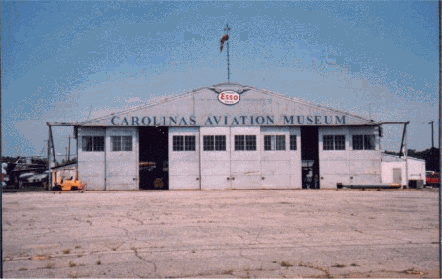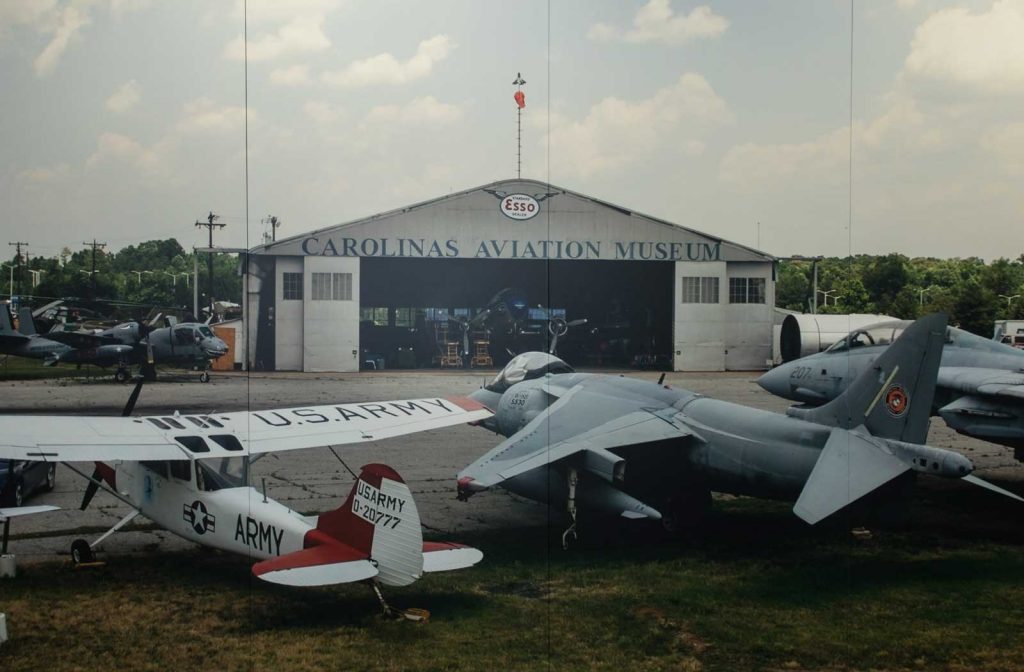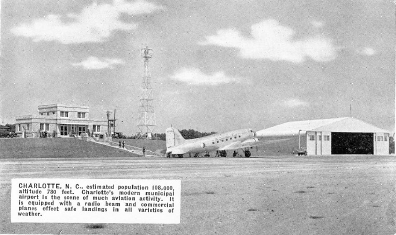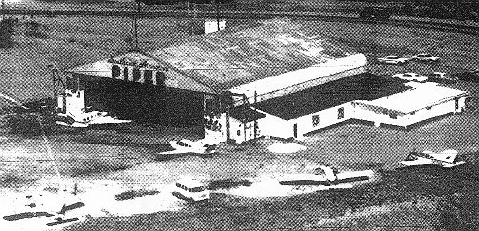Aviation City is one of three galleries in the new Sullenberger Aviation Museum. Located in the Historic WPA/Douglas Airport Hangar, the once and future site of the museum, Aviation City is about “place.” Watch the CLT airport grow during the golden age of aviation into the machine it is today, and see how it fueled the local economy, playing a critical role in shaping our Queen city. The historic hangar was registered as a Historical Landmark in 2002 with the assistance of Levine Museum of the New South Assistant Curator Ryan Sumner.

The economic impact of the airport on the Charlotte Region has grown exponentially since that time. Aviation City will open in late 2024 or early 2025 after careful restoration has been completed.
The following is excerpted from the 2002 Historical Landmark Commission Report prepared by Ryan L. Sumner (at that time Asst. Curator, The Levine Museum of the New South).

The WPA / Douglas Airport Hangar (“the hangar”), erected in 1936—1937 by the Works Progress Administration, was tied to a federal work program that preserved Charlotteans’ skills and self-respect during the Great Depression. Of the original structures built by the WPA. at the airport, only the hangar remains. During the Second World War, when the airport was dominated by Morris Field, the hangar serviced and stored planes for the civilian flights in and out of Charlotte. As the economy grew in the post-war years, so did the airport, which built bigger and more modern repair facilities. The hangar was then leased to small, chartered flight organizations until the mid-1980s when it was abandoned and fell into disrepair. The building of the airport contributed greatly to physical development of the city, expanding throughout its history to serve the air transport needs of the city.
Prior to the building of Douglas Airport, flights in and out of Charlotte were rare. The Queen City’s only airfield was Charlotte Airport (later known a Cannon airport), a small private venture operated by Johnny Crowell, a famed Charlotte aviator. Although this landing strip was christened amid much fanfare as an airmail stop on April 1, 1930,(1) with passenger service from Eastern Air Transport (later Eastern Airlines) following a few months later, the field was only open on weekends, for air shows, and war-pilot training.
For Charlotte Mayor Ben E. Douglas, this inadequate air operation did not fit his vision for Charlotte, which could not grow “without water and transportation.”(2) In an era when commercial flight was relatively new, Douglas continually pushed for a major municipal airport to serve the area.(3) Douglas convinced prominent Charlotteans of the necessity of an airport, gradually building up a base of support. In the summer of 1935, the Chamber of Commerce appealed to the City Council to provide adequate passenger and airmail service to and from the city.(4)
On September 3, 1935, Mayor Douglas led the Charlotte City Council in authorizing the City Manager to file an application with the Works Progress Administration for funding to build an airport.(5) The application was approved and on November 13, 1935, the council voted to divert funds in order to facilitate the purchase of land for the airport site and to repay the transfers upon the sale of airport bonds.(6) The bonds were sold on March 1, 1936.(7)
The Works Progress Administration (WPA), created by President Franklin D. Roosevelt in 1935, is considered the most important New Deal work-relief agency. The WPA developed programs to create work during the massive national unemployment and economic devastation created by the Depression. From 1935 to 1943, the WPA provided approximately eight million jobs at a cost of more than eleven billion dollars and funded the construction of hundreds of thousands of public buildings and facilities. By the end of 1939, 125,000 North Carolinians who were “caught between the grindstones of a maladjusted economy” had sought gainful employment from the state’s 3984 Works Progress Administration projects.(8)
Construction began in December 1935 under the direction of NC-WPA director George Coan and John Grice, Charlotte Regional WPA Director.(9) Hundreds of unemployed men, bundled in overcoats, stood in line for the first WPA. jobs, which consisted of clearing the site of trees and underbrush. One hundred and fifty of those men found work on the airport the first day.(10)
Many of those present had no means of transportation and walked six or more miles to the airport site.(11) The Charlotte airport project grew into the WPA’s largest project, in allotted funds, until that point; WPA funds accounted for $323,889.47, which were combined with an investment by the City of Charlotte $57,703.28. Of this money, $143,334.96 was paid in salary to the workers on the site.
When WPA construction ceased in June 1937, the new Charlotte Municipal Airport boasted an administration/terminal building, a single hangar, beacon tower, and three runways—two 3,000 feet-long landing strips and one 2,500 feet-long strip, each 150 feet wide.(12) The following year, the U.S. Department of Commerce added a “Visual-type Airway Radio-beam” system and a control building, which allowed pilots to engage in blind flying and blind landing.(13) Of these structures, only the Hangar remains.
The City Council wasted no time putting the new airport to use. They appointed an airport commission, chaired by William States Lee, Jr., to operate the new facility. Eastern Airlines flew the first plane into the new airport on May 17. Six daily flights took off from Charlotte Municipal Airport in its first year of operation; by 1938, the number of flights increased to eight. In 1940, the city officially dedicated the site, “Douglas Municipal,” in honor of the mayor who spearheaded the movement to build the airport.

The Recently Completed Municipal Airport Collection of the Levine Museum of the New South

The Hangar while leased by Southern Airmotive, c. 1980s
From the Charlotte Observer:
As a result of neglect and Hurricane Hugo, Charlotte’s last original airport building had fallen into a state of great disrepair by the early 1990s. Nearly all the windows were smashed, and the doors damaged. The structure was overgrown with kudzu. The hangar was filled with several years’ worth of scrap and general aviation junk, while a thirty-foot mound of hurricane-related debris was piled against the outside. The Airport slated the building to be razed.(19)
Aviation historian Floyd Wilson met with Airport Director Jerry Orr and convinced him to spare the building and allow it to be turned into a museum. In 1991, Wilson formed the Carolinas Historic Aviation Commission (CHAC) and held several successful fund-raisers to restore the hangar.(20) Under Orr’s direction, the airport provided a security fence, replaced the broken glass, sandblasted and repainted the walls, and repaired the doors to working order.(21) Today CHAC operates the facility as the Carolinas Aviation Museum, displaying a wide variety of aircraft, plus military and aviation-oriented memorabilia.
The growth of Charlotte/Douglas International Airport and the growth of the Charlotte Region are tied closely together. The airport links Charlotte with markets in the United States and around the world – an important factor in today’s global economy. According to a 1997 report by the UNC Charlotte Urban Institute, the airport contributes nearly four billion dollars in annual total economic impact to the Charlotte region, providing 71,392 jobs to workers who earn $1.968 billion in wages and salaries.(22)
Endnotes:
1. Charlotte Observer, (April 2, 1930), p1.; Charlotte Observer, (December 11, 1930); Blythe, LeGette and Charles Brockman, Hornet’s Nest: The Story of Charlotte and Mecklenburg County, (Charlotte, NC: Heritage Printers, 1961), p265-6
2. Carter, Gary, “Ben Douglas, Sr.: Charlotte’s Former Mayor Lives in a Future of His Own Creation,” Clippings Folder, Ben E. Douglas Papers, Robinson-Spangler Carolina Room, Public Library of Charlotte and Mecklenburg County.
3. Carter, Gary, “Ben Douglas, Sr.: Charlotte’s Former Mayor Lives in a Future of His Own Creation,” Clippings Folder, Ben E. Douglas Papers, Robinson-Spangler Carolina Room, Public Library of Charlotte and Mecklenburg County.
4. Carter, Gary, “Ben Douglas, Sr.: Charlotte’s Former Mayor Lives in a Future of His Own Creation,” Clippings Folder, Ben E. Douglas Papers, Robinson-Spangler Carolina Room, Public Library of Charlotte and Mecklenburg County.
5. Charlotte City Clerk, Minutes of the City Council (Special Meeting September 3, 1935).
6. Charlotte City Clerk, Minutes of the City Council (Nov. 13 1935).
7. Douglas, Ben E., “Ledbetter, L. L., City Treasurer to Ben E. Douglas,” (March 11, 1960), Ben E. Douglas Papers /Manuscript 109 , University of North Carolina, J. Murray Atkins Library Special Collections.
8. United States and Works Progress Administration North Carolina, North Carolina W.P.A.: Its Story (Information Service: 1940) .p1
9. Douglas Ben E., History of the Airport Scrapbooks, storage in the Robinson-SpanglerCarolina Room, Public Library of Charlotte and Mecklenburg County (labeled photographs)
10. Douglas, Ben E., History of the Airport Scrapbooks, storage in the Robinson-Spangler Carolina Room, Public Library of Charlotte and Mecklenburg County (undated unnamed newspaper clipping, circa Dec 1935)
11. Charlotte Observer (April 25, 1982)
12. Charlotte Observer (February 28, 1950)
13. Douglas Ben E., History of the Airport Scrapbooks, storage in the Robinson-Spangler Carolina Room, Public Library of Charlotte and Mecklenburg County.
14. Charlotte News (April 19, 1941).
15. Charlotte News (April 19, 1941); Charlotte Observer (February 28, 1950)
16. Charlotte City Directory (1941, 1942, 1943, 1944, 1945, 1946); Interview with Fred Wilson, President Carolinas Historic Aviation Museum (April 1, 2002)
17. Dedication Program (July 10, 1954), Douglas Airport, Clippings Folder, Robinson-Spangler Carolina Room, Public Library of Charlotte and Mecklenburg County.
18. Kratt, Mary and Mary Boyer, Remembering Charlotte: Postcards from a New South City, 1905—1950, (Chapel Hill, NC: University of North Carolina Press, 2000) p128
19. Interview with Fred Wilson, President Carolinas Historic Aviation Museum (April 1, 2002)
20. Charlotte Observer (October 21, 1992)
21. Charlotte Observer (October 21, 1992)
22. Charlotte/Douglas International Airport, Official Website. Available at: http://www.charlotteairport.com/economic.htm
Read the Full Report:
http://landmarkscommission.org/2016/10/04/w-p-a-douglas-airport-hangar/
Reprinted from Charlotte Mecklenberg Historic Landmark Commission website, Accessed Tuesday September 5, 2023.
